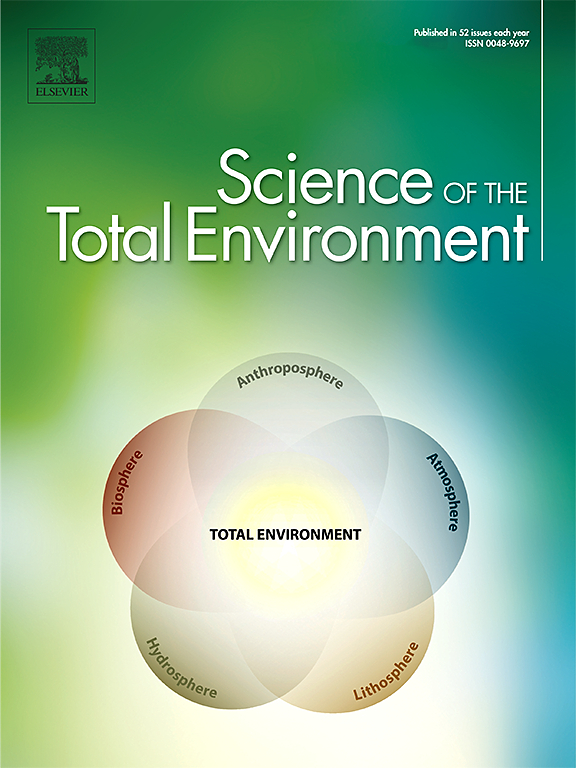Environmental risks of heavy metals in railway soils: Challenges to ecosystem management
IF 8
1区 环境科学与生态学
Q1 ENVIRONMENTAL SCIENCES
引用次数: 0
Abstract
Heavy metal contamination near high-traffic railways presents serious risks to food safety, particularly in agricultural regions adjacent to rail transport corridors. This study investigated heavy metal in soils and wheat plants along the Arak-Tehran railway in Iran, focusing on how distance from the railway and soil depth influence contamination levels. Soil and plant samples were collected at intervals from 0 to 300 m away from the railway to assess the concentrations of nickel (Ni), cadmium (Cd), lead (Pb), and zinc (Zn). The findings indicated that heavy metal concentrations decreased with increasing distance from the railway, with surface soils showing higher contamination than subsurface soils. Soil parameters like Organic matter, calcium carbonate, and cation exchange capacity were positively correlated with the absorption of heavy metals. The Geoaccumulation Index (Igeo) classified the area as highly polluted, particularly by cadmium (Igeo = 6.39), nickel (Igeo = 6.72), and lead (Igeo = 4.01). Contamination factor (Cf) values for nickel (158.47), cadmium (125.67), and lead (24.23) along with the average Pollution Load Index (PLI) of 31.5, confirm severe soil contamination. The translocation factor analysis revealed that cadmium had the highest translocation rate from roots to shoots, followed by zinc, nickel, and lead. Both the aerial and root parts of wheat contained heavy metal concentrations exceeding FAO/WHO safety limits, posing a potential health risk to populations consuming crops from this area. Despite high soil contamination, heavy metals were efficiently transferred to the aerial parts of the wheat, particularly cadmium and lead. These findings underscore the health risks posed populations consuming wheat and other crops grown in agricultural zones near the Arak-Tehran railway, where heavy metal contamination from the railway infrastructure can impact food safety.

铁路土壤重金属环境风险:生态系统管理的挑战
高流量铁路附近的重金属污染对食品安全构成严重威胁,特别是在铁路运输走廊附近的农业区。本研究调查了伊朗阿拉克-德黑兰铁路沿线土壤和小麦植物中的重金属,重点关注与铁路的距离和土壤深度如何影响污染水平。在距离铁路0 ~ 300 m的间隔处收集土壤和植物样本,评估镍(Ni)、镉(Cd)、铅(Pb)和锌(Zn)的浓度。结果表明,随着离铁路距离的增加,重金属浓度逐渐降低,表层土壤污染程度高于地下土壤。土壤有机质、碳酸钙、阳离子交换容量等参数与重金属吸收呈正相关。地质堆积指数(Igeo)将该地区列为重度污染地区,特别是镉(Igeo = 6.39)、镍(Igeo = 6.72)和铅(Igeo = 4.01)。镍(158.47)、镉(125.67)和铅(24.23)的污染因子(Cf)值以及平均污染负荷指数(PLI)为31.5,证实土壤污染严重。转运因子分析表明,镉从根向茎的转运速率最高,其次是锌、镍和铅。小麦的地上部分和根部所含重金属浓度均超过粮农组织/世卫组织的安全限度,对食用该地区作物的人口构成潜在的健康风险。尽管土壤污染严重,但重金属仍有效地转移到小麦的地上部分,尤其是镉和铅。这些发现强调了在阿拉克-德黑兰铁路附近的农业区食用小麦和其他作物的人群所面临的健康风险,因为铁路基础设施造成的重金属污染会影响食品安全。
本文章由计算机程序翻译,如有差异,请以英文原文为准。
求助全文
约1分钟内获得全文
求助全文
来源期刊

Science of the Total Environment
环境科学-环境科学
CiteScore
17.60
自引率
10.20%
发文量
8726
审稿时长
2.4 months
期刊介绍:
The Science of the Total Environment is an international journal dedicated to scientific research on the environment and its interaction with humanity. It covers a wide range of disciplines and seeks to publish innovative, hypothesis-driven, and impactful research that explores the entire environment, including the atmosphere, lithosphere, hydrosphere, biosphere, and anthroposphere.
The journal's updated Aims & Scope emphasizes the importance of interdisciplinary environmental research with broad impact. Priority is given to studies that advance fundamental understanding and explore the interconnectedness of multiple environmental spheres. Field studies are preferred, while laboratory experiments must demonstrate significant methodological advancements or mechanistic insights with direct relevance to the environment.
 求助内容:
求助内容: 应助结果提醒方式:
应助结果提醒方式:


